Finding a ton of keywords is one thing, but knowing which keywords are actually useful to your SEO campaign is another thing altogether.
Keyword research—the process of uncovering keywords and search terms—can only take you so far. You need to conduct keyword analysis to narrow your selection down to the most relevant and profitable terms.
You can perform keyword analysis by looking at the difficulty, monthly search volume, the search intent behind the query, and conversion potential of individual search terms. By doing this, you discover the keywords that work best for you.
Today, I’m going to show you how to cherry-pick the keywords that will best complement your current SEO strategy.
What is Keyword Analysis?
Keyword analysis is the second stage of keyword research. Once you’ve gleaned competitors’ blog posts for keyword ideas, or used search engines to uncover long-tail keywords, what do you do with them?
Don’t overstretch your SEO strategy to target every single keyword you’ve found.
While all of these keywords will be related in some way to the main focus of your blog, some may not fit the object of your domain (we’ll get to this in a second).
Instead, you should conduct keyword analysis to determine which search terms could actually benefit your campaign.
Not only that, but keyword analysis can also help you determine which keywords are most important.
Specifically, keyword analysis can help you target keywords that are within your reach, and determine the ones that are too difficult to try.
It can also help you determine the reason why web searchers use certain keywords in their search terms so that you can create content that better matches up with the intent behind their search query.
Above all, performing keyword analysis can help you determine which keywords to target first.
For example, if you’ve conducted keyword research for a paleo diet blog you’re about to start, and your list of keywords includes the likes of:
- Caveman diet
- Stone age diet
- Paleolithic nutrition
- Hunter-gatherer diet
- Grain-free diet
- Healthy fats
- Low-carb diet
- Grass-fed meats
Some of these may not be worth targeting initially as the competition for them may be too fierce. Or, some may not be as directly relevant to your SEO campaign as others.
So, how do you determine which ones to target first?
Besides using common sense, there are a few key metrics you can use to determine which keywords to target (and which ones to put aside for the time being).
These key metrics can all be analyzed using Semrush’s Keyword Overview tool.
This is the keyword analysis part of the research process.
How to Conduct Keyword Analysis
Keyword analysis can be conducted by examining the keyword difficulty, monthly search volume, conversion potential, and the intent of a keyword.
With Semrush’s Keyword Overview tool, here’s how you conduct keyword analysis:
Keyword Difficulty
Keyword difficulty, or “SERP competition”, refers to how difficult it would be to rank for a given keyword.
The difficulty of a keyword is determined by the authority level of the other domains that rank for the keyword. For example, if I were to put “paleo diet” into Keyword Overview, here’s what would come up:
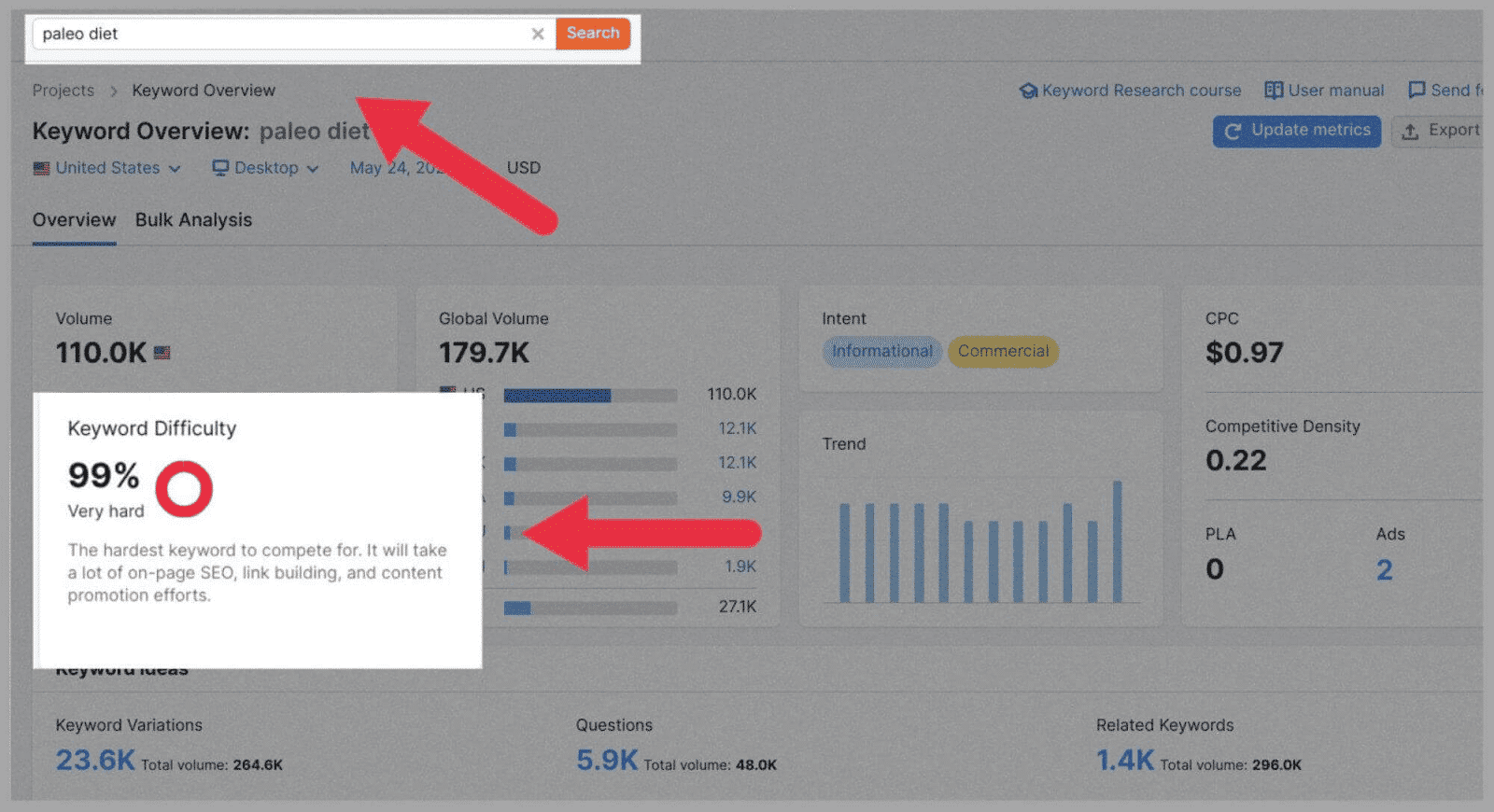
In the Keyword Difficulty section on the left, you can see that this search term currently has a score of 99%, indicating that it’s very hard to rank for.
Keyword difficulty is a good metric to determine what keywords to use as it reflects the chances you have of ranking for that keyword yourself.
In this case, ranking on page #1 of the SERPs for this keyword alone would be next to impossible. This begs the question, what percentage of keyword difficulty should you target as a start-up website?
Here’s what happens when I throw another keyword “hunter-gatherer diet” in the tool:

66% is better than 99%, but still not ideal.
Semrush splits its keyword difficulty percentages into several categories, which include:
- 0-14% = Very easy
- 15-29% = Easy
- 30-49% = Possible
- 50-69% = Difficult
- 70-84% = Hard
- 85-100% = Very hard
As a start-up or low-authority website, you should aim for the very easy/easy brackets. If you’re unsure of your authority score, you can check this in Semrush’s Domain Overview, as shown here:

It’s worth noting here: keyword difficulty is just one of several metrics you should use when conducting keyword analysis.
You shouldn’t totally ignore a keyword just because it has a high score. As your domain authority improves, you can start targeting keywords with higher scores.
Similarly, you shouldn’t throw all your budget and time at a keyword just because it has a low score. You need to also judge the keyword based on monthly search volume, search intent, and conversion potential.
Monthly Search Volume
Another metric you can see in Keyword Overview is “Volume”:
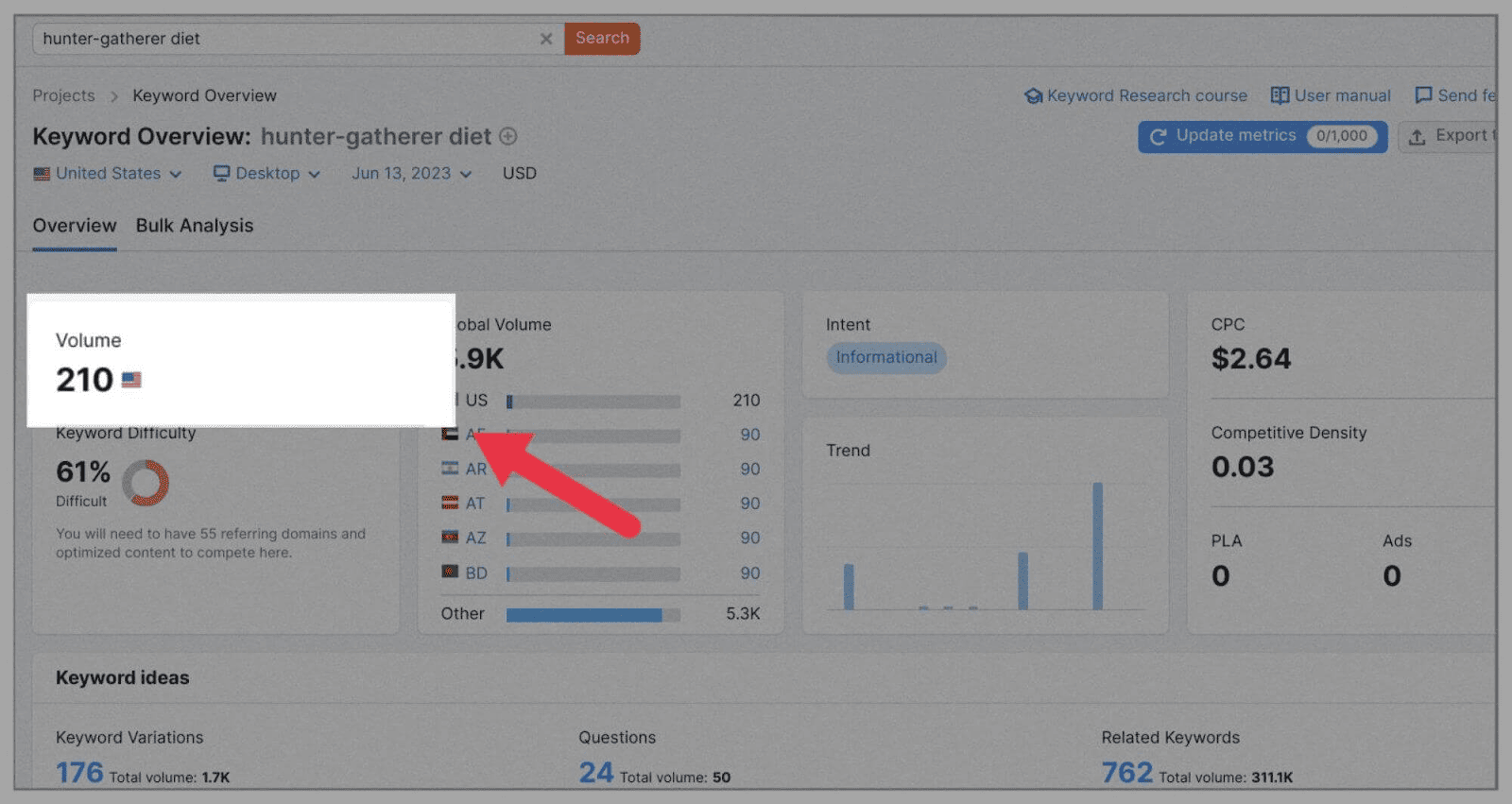
This metric is an estimate of how many times your keyword was searched nationally over a month (Semrush updates this metric once per month). The higher this volume, the more online interest there is regarding the keyword.
You can also check on international, regional, and historical search volumes of any given keyword (which will benefit you when conducting specialist methods of keyword analysis—more on this later).
The volume metric holds several benefits, including that it allows you to estimate the traffic potential of a keyword.
Here’s an example of an extremely high-volume keyword:

The keyword “Bitcoin Price” has a cool search volume of 6.1 million in the US. However, like “Paleo Diet”, it would be incredibly hard to rank for this particular keyword.
A high search volume is pretty much always indicative of high keyword difficulty.
However, you could use the monthly search volume metric to compare several keywords with low keyword difficulties. This will help you determine which to target first.
A monthly search volume of between 100 and 1,000 is often a good place to start.
But it’s worthwhile to note: search volume is not exactly the most reliable keyword metric either. Results are, after all, just an estimate, and tend to become less accurate the less difficult the keywords are to rank for.
While it’s important to consider, search volume should never be your main port of call when it comes to keyword analysis.
Conversion Potential
While still in Semrush’s Keyword Overview, you should also check on the conversion potential. Conversion potential is how likely a web user is to buy your product, sign up for your mailing list, and so on.
The more the keyword is worth, the higher the conversion potential—but how do you measure a keyword’s worth?
This is best reflected by cost-per-click (CPC), which can be found on the right side of the Keyword Overview tool, shown here:

This metric shows how much advertisers are currently bidding on this keyword. A high CPC is normally indicative of a popular keyword that multiple advertisers are bidding on to appear in the SERPs.
If high bids are being thrown at this keyword, it must have a high conversion potential. For example:

“Paleo Diet” has a current CPC of $0.97. Although this isn’t a significant price, it suggests that the keyword holds strong conversion potential.
Keywords that have a low keyword difficulty, a steady search volume, a decent conversion potential, and hold real relevance to your topic are definitely worth targeting over keywords that don’t meet these four requirements.
Keyword Intent
Simply including a keyword in your content isn’t the same as “targeting a keyword”. To accurately target a keyword, you need to understand the reason why the keyword is being searched for.
Misunderstanding keyword intent is where a lot of content goes awry. If your content does not accurately match up with searchers’ needs, what purpose does your content serve? Other than looking spammy and irrelevant, not much.
In order to understand keywords, you need to understand the reason why web users are using them in their search queries. Then, you can build content that answers these queries.
Think of search intent from a search engine’s point of view: Google is trying to create a service where it matches search queries with relevant sources of information.
But how do you analyze keywords to understand search intent?
You can start by categorizing your keywords. The main search intent categories include:
- Informational—When users require information on something. I.e., “how long does it take to build a six-pack?”
- Commercial—When users require information to help them make a buying decision. I.e., “top 10 protein shakes for building muscle”.
- Navigational—When users are looking for a specific page, i.e., “Strava log-in page”.
- Transactional—When users have a specific purchase in mind and are ready to buy, i.e., “buy a dumbbell set”.
You can normally identify the keyword intent by looking at how the search term is worded. For example, “why…” generally leads to an informational search, and “buy…” tends to lead to a transactional search.
Or, you could check for Intent on Semrush’s Keyword Overview tool:

This shows us that the search intent behind “paleo diet” is mostly informational and commercial.
Search intent influences all aspects of your keyword analysis. You shouldn’t just look at monthly search volume without also looking at search intent.
Why Analyzing Keywords is Important
As we’ve explored above, keyword analysis is done to separate relevant and profitable keywords from the ones that’ll hold you back.
But how does conducting keyword analysis really help you and your SEO campaign? Here’s how:
It helps you budget wisely
You can expertly pick out the keywords that hold conversion potential, instead of throwing your money at keywords that won’t convert. This way, you increase the chances of gaining a good return on investment.
It helps you manage your time
Knowing the individual importance of each keyword helps you to better plan out your content strategy timeline. You can focus on creating content that will make a difference to your domain authority, rather than wasting days creating content that won’t.
It helps you reach the SERPs
You can target keywords that you can rank for in the meantime, instead of chasing highly competitive keywords that you won’t rank for immediately.
…and build authority
Once you reach the SERPs for several low-difficulty search terms, you may gain enough domain authority to target the bigger, more competitive keywords.
Analyzing Keywords Also Helps You Create A Keyword Map
Another massive way that analyzing keywords helps you on your SEO mission is the mapping of your site. It is so helpful, in fact, that this point deserves a section all to itself.
In case you don’t know: You need to create a keyword map in order to keep your website organized and avoid keyword cannibalization issues, which is when you have more than one page written on the same topic and attempt to rank for the same keyword.
But how do you make a keyword map and what does it have to do with keyword analysis?
Let me explain:
Keyword mapping is the process of assigning a unique focus keyword to each of your site’s pages. Each page of your site should be built around this main keyword—it suggests the purpose of the page, which helps search engines define it.
An example of a main keyword would be something like “The Benefits of the Paleo Diet”. You should also have variations of this keyword ready to swap in to avoid your content appearing too spammy. For example, “Paleo Diet Benefits”, “Pros of the Paleo Diet”, etc.
On each page, the focus keyword (and its variations) will appear in the URL, title, and in some of the headings. Below this main keyword, there’ll be a list of secondary supporting keywords—or keyword clusters, as they’re referred to—that hold direct relevance to the main term.
Ideally, these secondary supporting keywords should be sprinkled throughout your content.
As you research and analyze your keywords, you’ll naturally establish primary terms that’ll serve as your main keywords. These will be prominent, popular search terms that you’re seeking to directly address in your content.
Through the help of the Keyword Magic Tool, you can establish secondary keywords that help answer the search intent of the main keyword.
Creating these keyword clusters helps organize your site as it means that each page can target a different selection of keywords. This brings order to your website and keeps topics well-defined and separate.
You don’t risk running into keyword cannibalization issues, And the best way to create solid and well-defined keyword clusters?
By performing keyword analysis!
Keyword Analysis Tools
As I go into detail about the different specialist methods of analyzing keywords in the next section, it would be useful to first give you a rundown of the best tools to use—especially before we get to the specialist methods section of this guide.
The best keyword research tools I use include:
Semrush
You should make Semrush your go-to suite both for keyword research and analysis. It’s a multi-faceted toolbox that can help you out at all stages of your SEO campaign. It can provide great keyword suggestions, review your backlink profile, or help you perform competitor keyword analysis.
Google Analytics
Google Analytics is most useful for analyzing keywords that are already on your site (we’ll explore this more in the Analyzing Keyword Ranking section below). It’s important for understanding what leads visitors to your site, and determining how to attract more in the future.
Google Trends
Google Trends is a tool that allows you to analyze the current and long-term popularity of keywords.
It’s important for keyword analysis as it helps you determine the best times of year to target specific search terms. It also allows you to review current and past spikes in popularity for specific keywords.
I’ll detail how to implement Google Trends into your keyword analysis in the Seasonal and Trending Analysis section below.
Google Keyword Planner
Google Keyword Planner is mostly useful for keyword research purposes, but it can also be used to thoroughly analyze your keywords once you’ve collated them.
You can check the keyword volume, trends, CPC, and competition level of each keyword suggestion that the tool suggests, as shown below:

Does this remind you a lot of Semrush’s Keyword Manager? Well, they serve pretty much the same purpose.
However, Google Keyword Planner has a slight advantage in that it’s totally free to use, an unlimited amount of times.
Analyzing Keywords: Specialist Methods
Now that we’ve covered how to determine search volume, keyword difficulty, search intent, the commercial potential of keywords (and the tools you need), here’s how you can kick your keyword analysis up a notch:
Local and Geo-Targeted Analysis
Local keywords—or, geo-targeted keywords, as they are sometimes referred to—are keywords that target a specific audience in a specific area.
Google likes to help web users find direct answers to their questions. So, if they were to search for “plumber near me”, Google will look at your location settings and throw up results based on your stated location.
Rather than providing you with a long list of all the plumbers in the US, it makes much more sense to give favor to the plumbers in your local area.
If your business is offering a localized service or product, you can take advantage of Google’s need to provide web users with local results.
This can be done by including the name of your location next to one of your seed keywords. I.e., “Plumbers in New York City”.
However, to appear in search results for spatial terms such as “nearby”, “local”, and “near me”, you need to go a lot more specific.
If your plumbing business is based near Central Park, your location terms can include:
“Central Park”, “New York City”, “110th Street”, and “Manhattan”.
Next, head back over to Semrush’s Keyword Magic Tool and type “Plumber” into the search bar and your location terms into the “Include Keywords” section (be sure to deselect “all keywords” and select “any keywords”) as shown below:
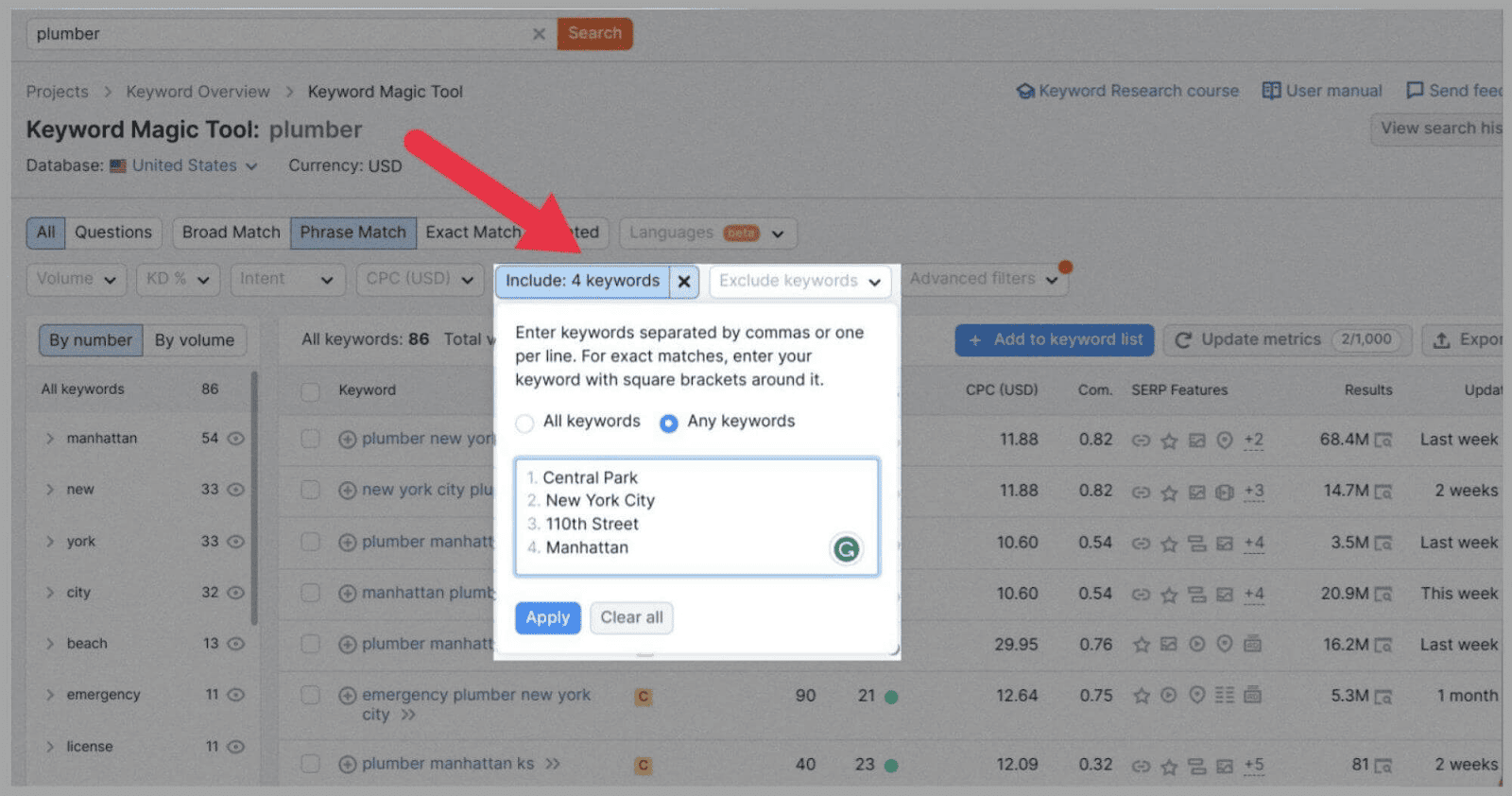
You’ll then be presented with a list of specific local and geo-targeted keywords, as shown here:
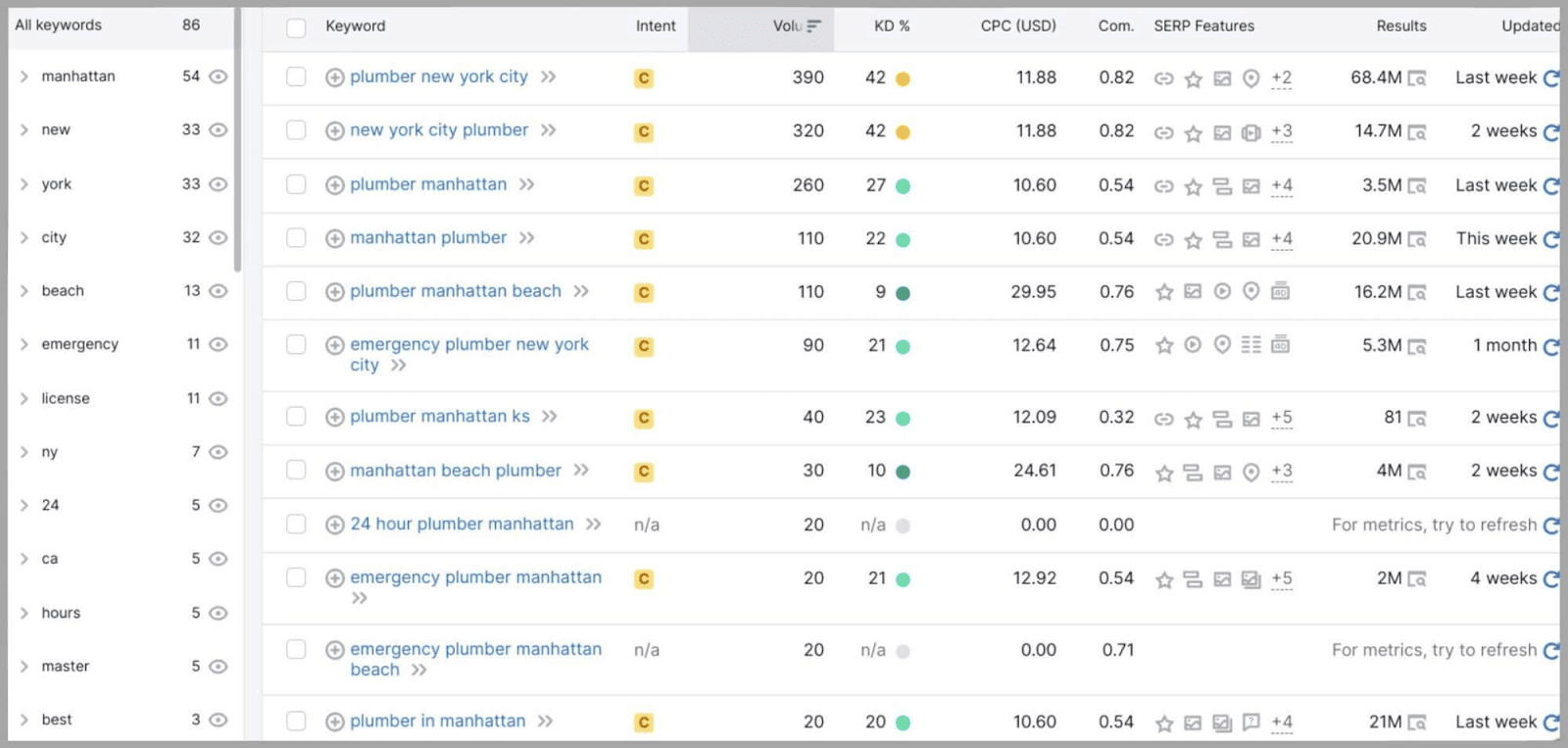
From here, not only can you select relevant search terms from these keyword suggestions, but you can also analyze them.
Check out the intent, volume, keyword difficulty, and CPC of each (displayed to the right of each keyword) and choose the ones that best align with your business.
In this example, “plumber Manhattan beach” has a high volume and CPC, but a surprisingly low keyword difficulty, as shown here:

So, it would be worth targeting this keyword in your content.
Seasonal and Trending Analysis
Seasonal keyword analysis involves examining how keywords rise and fall in popularity over time. Perhaps a specific search term is searched for regularly during the summer, and then minimally during the winter.
For example, “Christmas trees”, as a search term, is really only in the spotlight during one month of the year.
You can better organize your content strategy and marketing efforts knowing when specific keywords peak and fall in popularity.
Trending keyword analysis is a slightly different practice. It involves finding keywords that are currently search engine buzzwords of sorts. These keywords may not experience an annual rise and drop, but they’re currently being searched for a lot.
These emerging search terms will eventually reach saturation and fall in popularity. However, by performing regular trending analysis, you can identify emerging trends before it’s too late.
So, how do you carry out seasonal and trending keyword analysis?
Google Trends is the best tool for the job. You can use it to analyze over a day, a week, a month, a year, the past five years, and so on—all the way back to 2004!
Here’s how it works:
If I put a keyword you wouldn’t immediately think had seasonal relevance, such as “dog daycare”, here’s the kind of info this keyword analysis tool will provide:
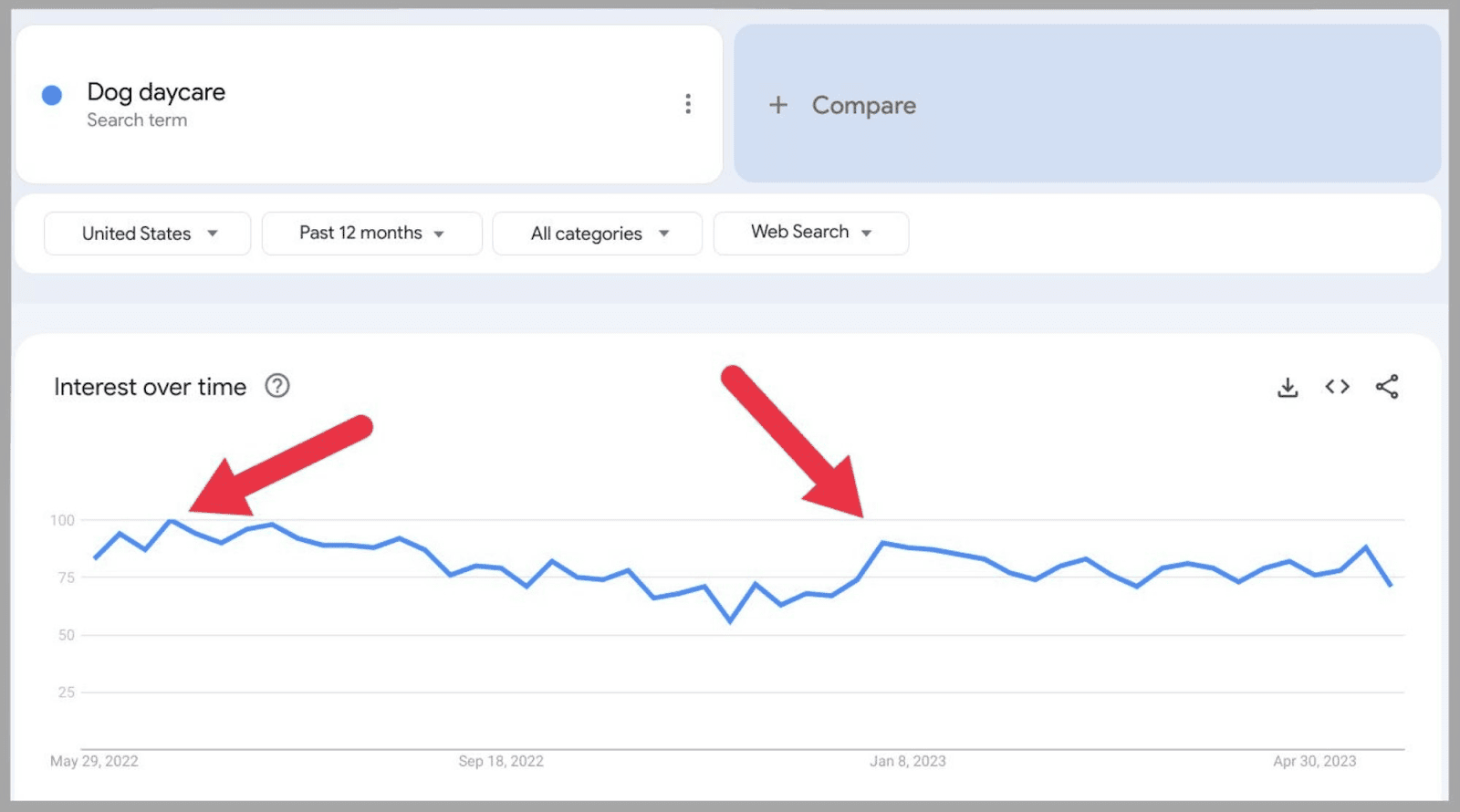
You can see that “dog daycare” peaked in popularity around June 2022, and then again throughout January of 2023. The summer spike probably reflects the high number of people looking for daycare services around vacation time.
The January spike could reflect the number of people looking for dog assistance upon returning to work.
If you scroll down, you can also check which states most of these searches were made in:

Further down still, you can review related topics and related queries:

Not only does this provide you with further keyword inspiration, but it also gives you a clear indication of when to target the keyword “dog daycare” (should you run a dog-related blog, that is!).
To give you an idea of how to perform trending keyword analysis, let’s take a massive buzzword from the last 12 months: ChatGPT.
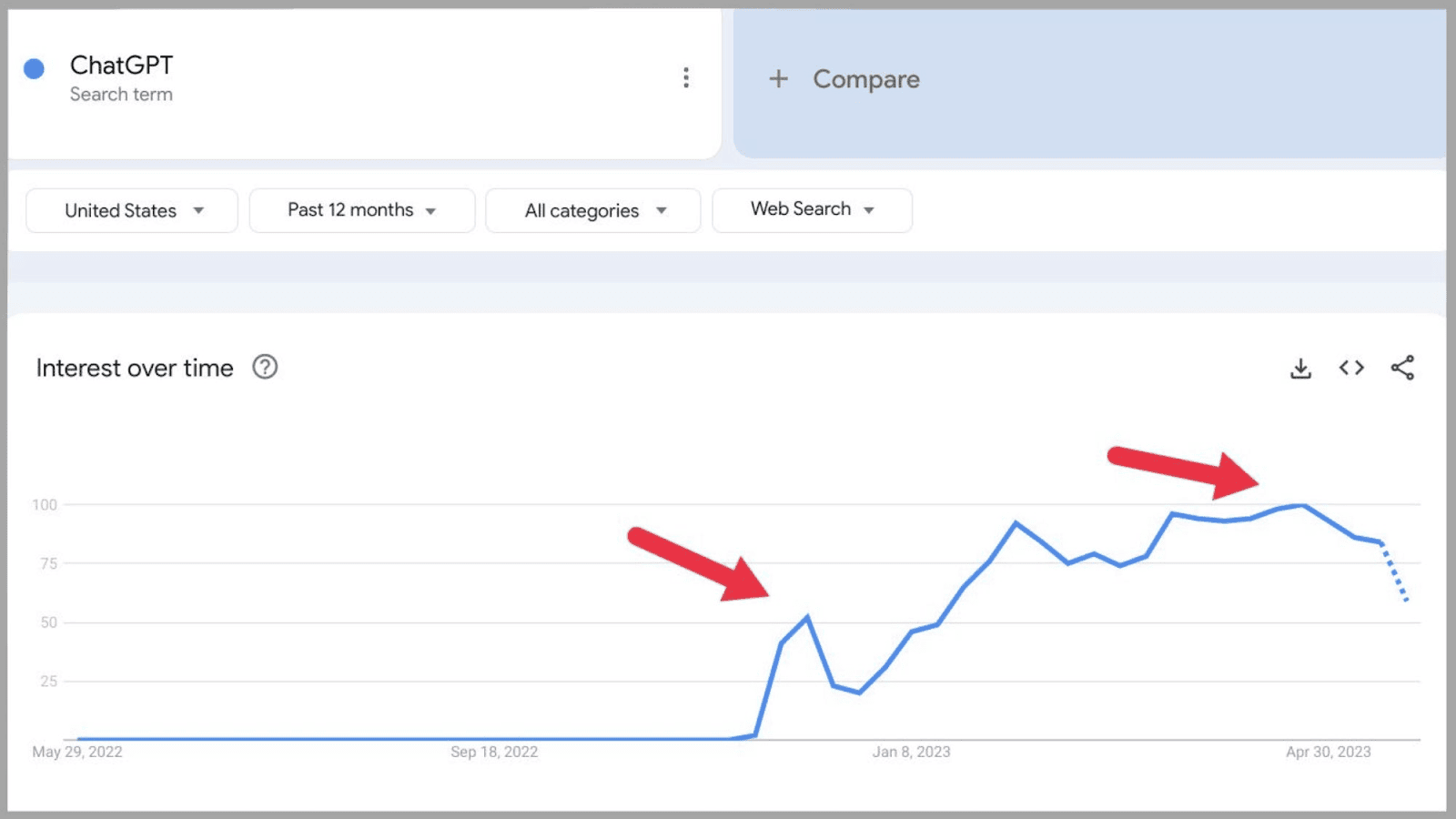
So, “ChatGPT” experienced an initial minor spike around mid-December, which pretty much doubled come early February. Search interest remained somewhat stable over February and peaked in April, before dropping slightly afterward.
Perhaps ChatGPT as a keyword has already saturated, and will never reach the heights it did earlier in the year. Or, renewed interest in the chatbot could revitalize it as a search term.
Either way, you definitely need to include Google Trends as part of your keyword analysis.
Keyword Analysis for Voice Search
You must also include voice search terms in your keyword analysis and incorporate the results into your content marketing campaigns.
Voice search terms can be drastically different from regular search terms, and need to be treated as separate entities as such. Voice searches are closer to how people actually speak, while typed-out search terms tend to be shorter and unlike natural human speech.
For example, voice searches often start with who, what, why, where, and when, and resemble a complete sentence, such as:
“What ingredients do I need for making a chocolate sponge cake?”
Typed searches often omit the interrogative word altogether, and more often look like this:
“Chocolate sponge cake ingredients”.
If you don’t optimize your content for both search methods, you’ll miss out on a significant level of search traffic.
To rank for voice search queries, you need to include plenty of long-tail keywords as well as question keywords in your content.
If you put your main keyword into Semrush’s Topic Research tool, you’ll be provided with a bunch of related questions that could help you rank for voice searches.
You can find these questions on the right-hand side of the Overview section:

By including some of these “Interesting Questions” throughout your content (either as H2s, H3s, or as part of an FAQ section) you’ll increase your chances of ranking for voice search queries.
However, instead of just picking these questions at random and sticking them in your content, you should run them through Keyword Overview for keyword analysis first.
Like how I do here:

Here, you can see that “How do I make a chocolate sponge cake” has the lowest keyword difficulty, which is definitely worth noting.
Keyword Gap Analysis
Keyword gap analysis is the process of comparing your own keywords to your competitors and identifying terms that they’re ranking for that you are not.
It’s a means of getting your site on the same level as your direct competitors, and also of generating new content ideas for yourself. If you fail to fill these gaps, your competitors will always be at least one step ahead of you.
Semrush’s Keyword Gap tool is the best keyword analysis tool for identifying keyword gaps. Here, you can compare your domain with four of your top competitors.
To give you an example, I’m going to compare my domain with Ahrefs, Moz, Wordstream, and Search Engine Journal.
Firstly, put the names of each of your competitors into the Keyword Gap tool, like this:

You’ll then see a basic overview of your keyword opportunities (both missing and weak) as well as a diagram displaying your keyword overlap, as shown below:
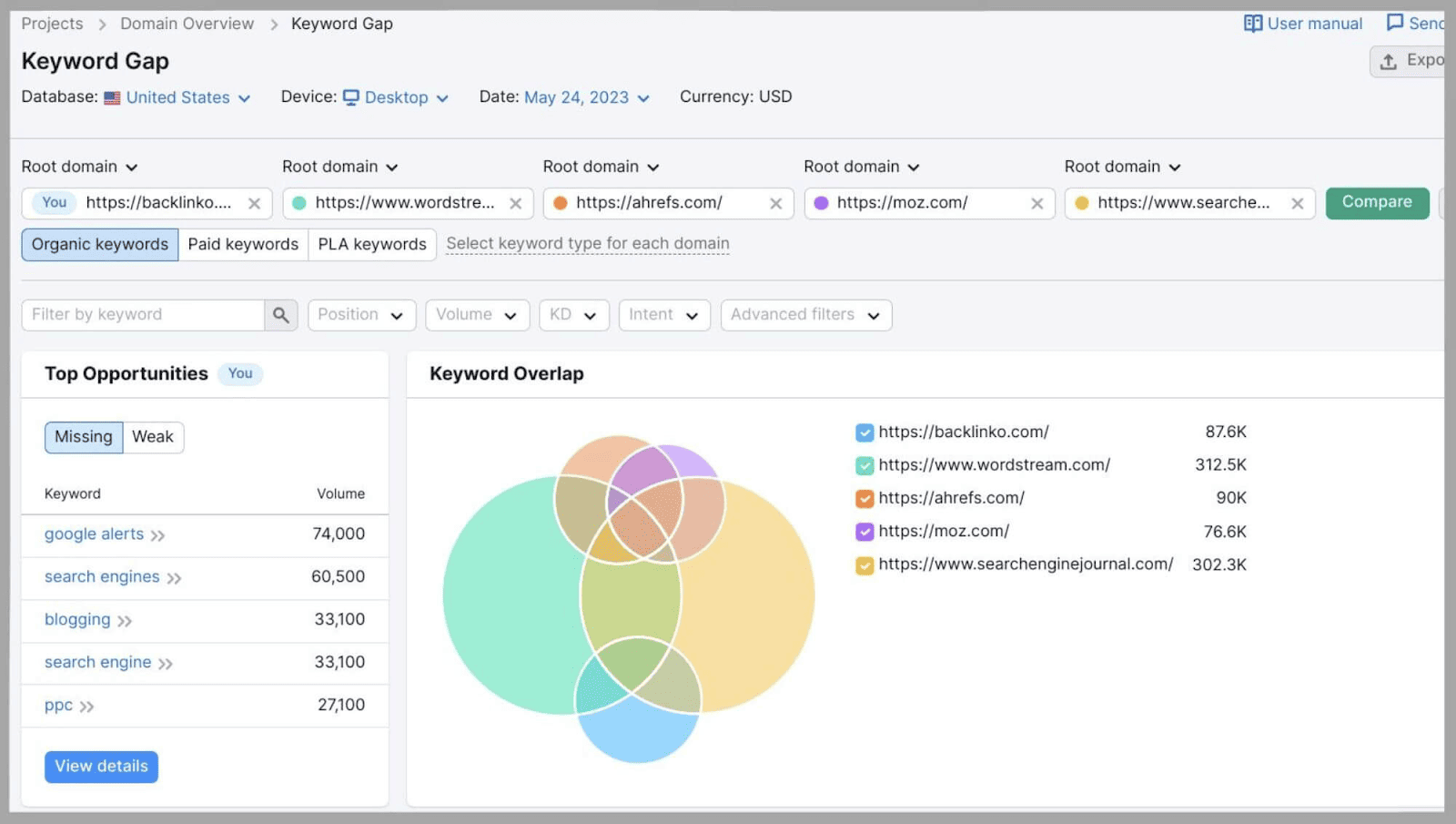
From this, we can see that Wordstream and Search Engine Journal have the most ranking keywords out of you and all your competitors.
If you hover your mouse over the center of the graph, you’ll see how many keywords all domains share in total:
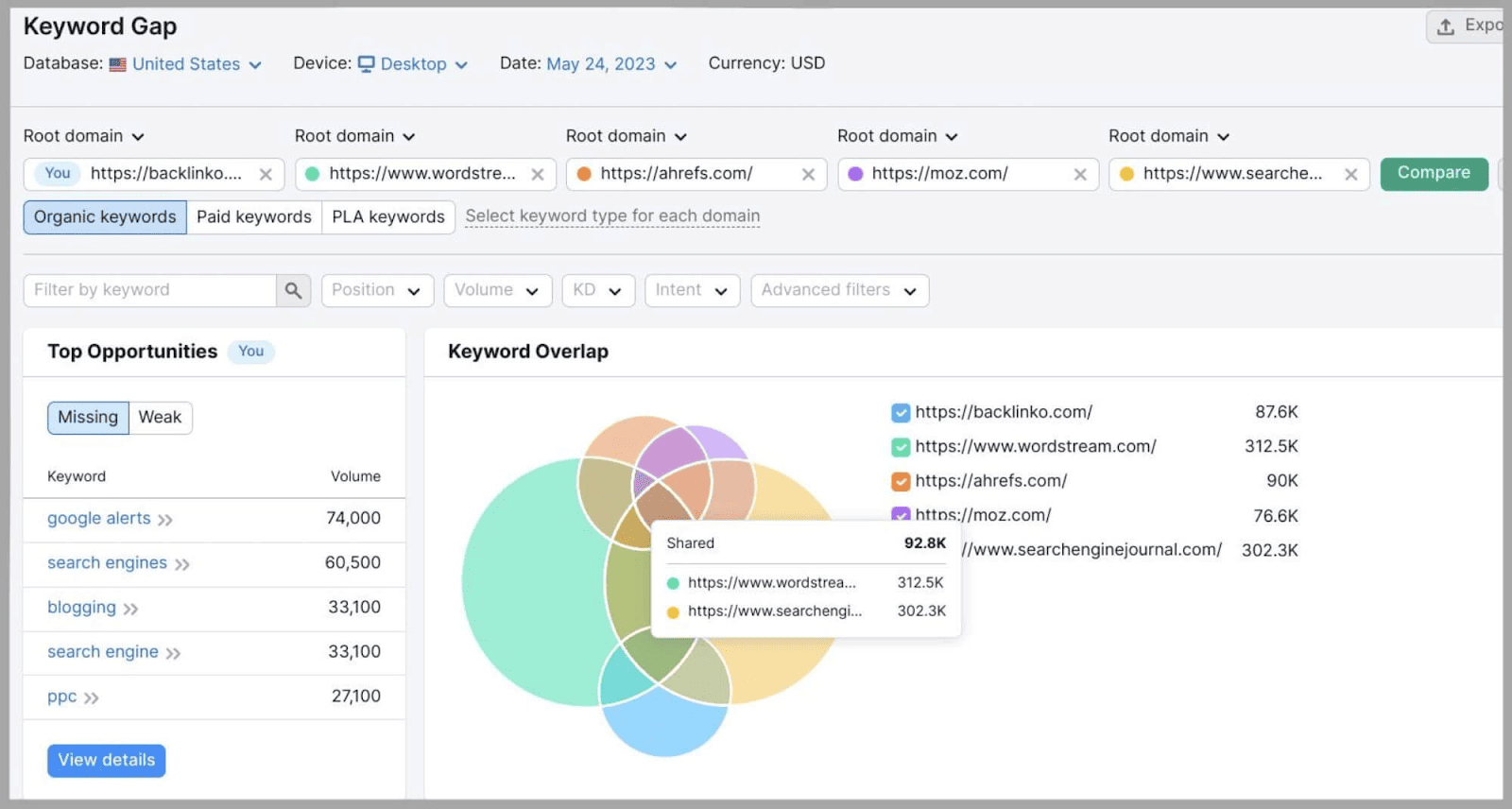
Which, in this case, is 92.8k!
While this is interesting, it doesn’t really help you research keywords.
You’ll find the stuff that actually helps you below the graph:
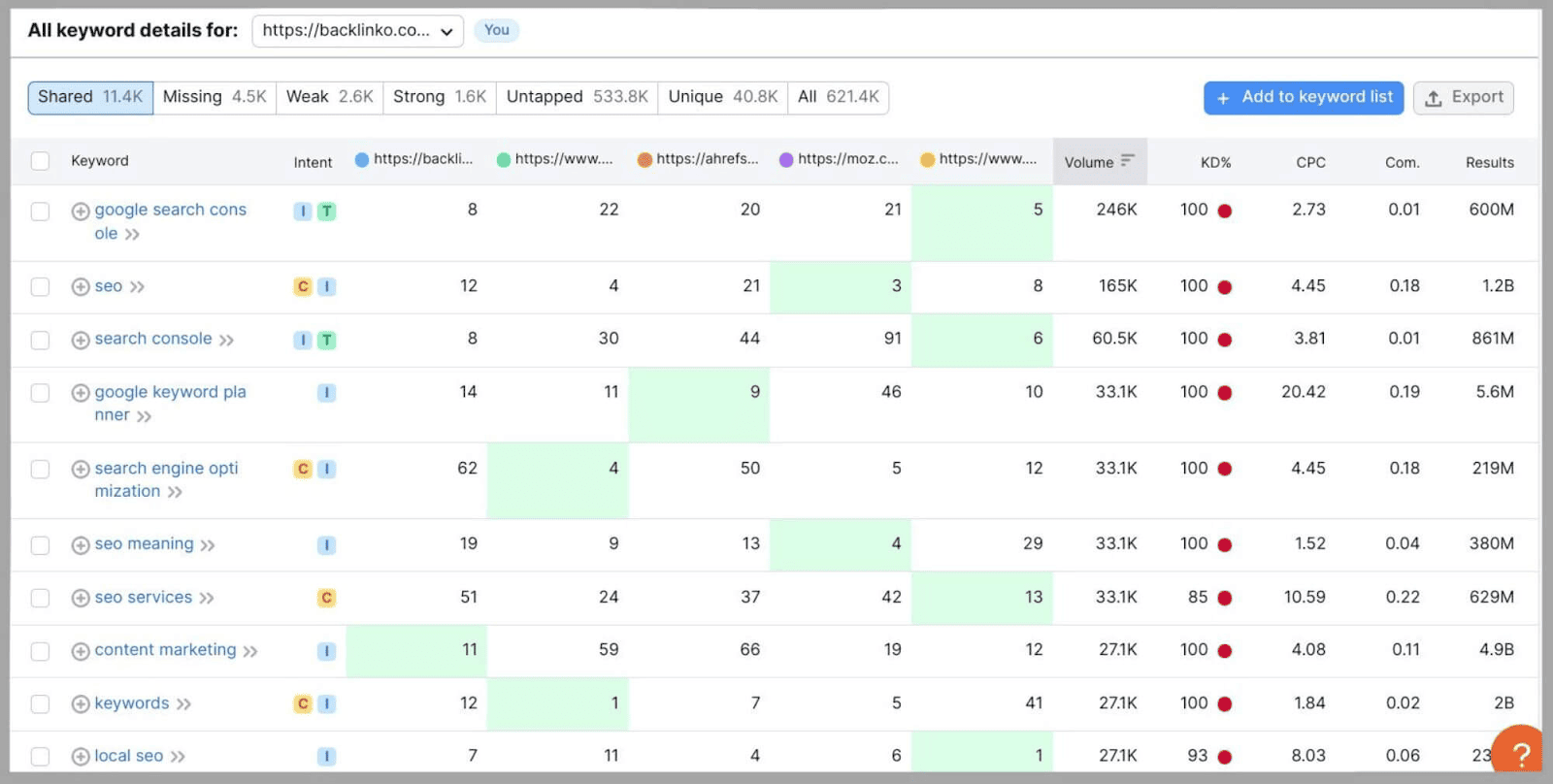
The table above shows you all the keywords you share with your competitors as well as the ones you lack.
It also provides you with useful metrics such as volume, keyword difficulty, and all the other bits of info essential to performing keyword analysis.
You can find filter options above the table. The two most important filter options for the purpose of keyword analysis are “Missing” and “Untapped”.
Here’s what happens when I click on “Missing”:

These are the keywords I currently don’t have in the content on my site.
From an analytical point of view, these keywords may be pretty tricky to rank for but are still worth taking note of (or adding to your Semrush keyword list).
In this instance, Semrush has provided me with 45 pages worth of missing keywords. Here’s what page 40/45 looks like:
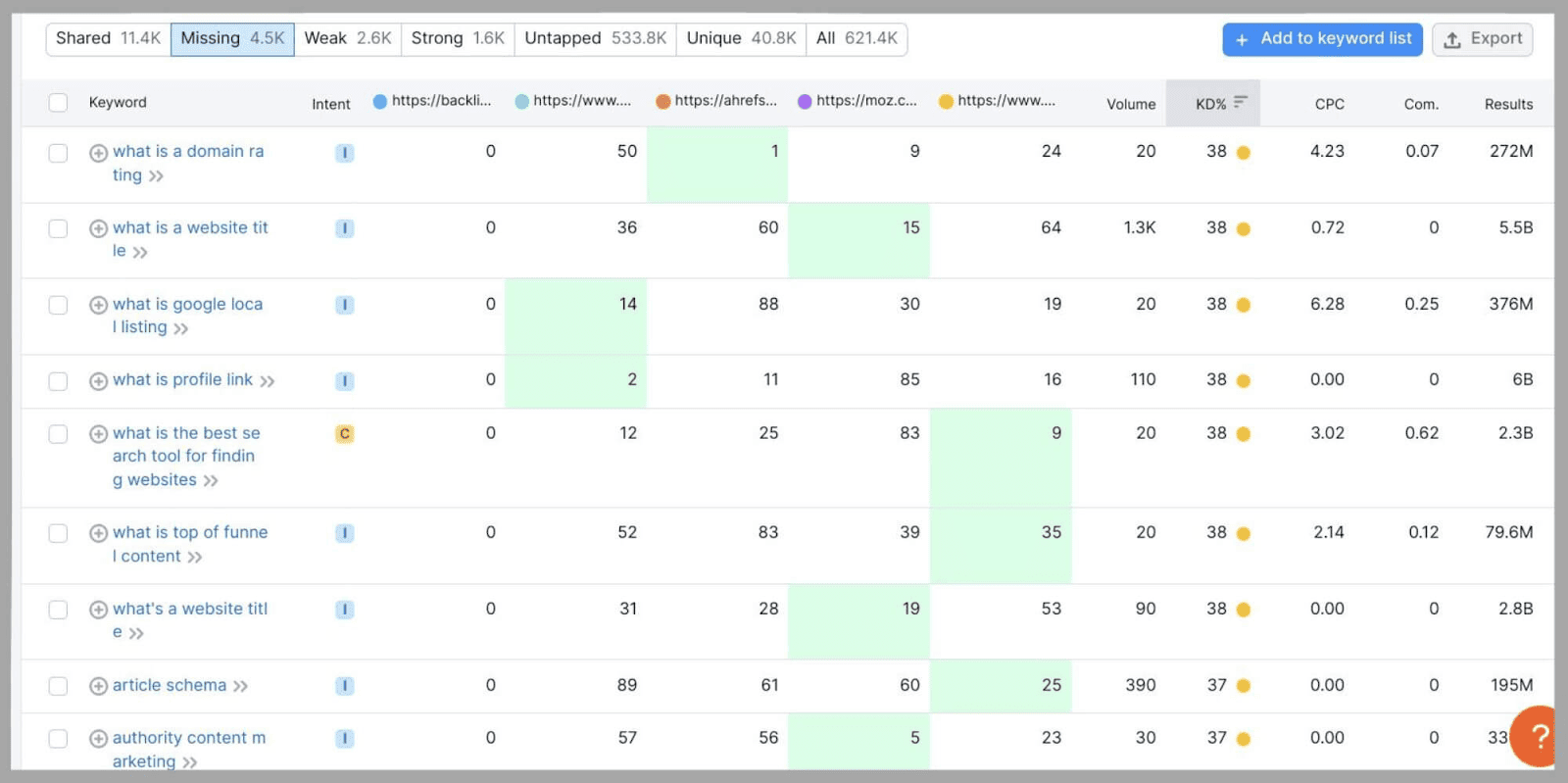
The second option down, “What is a website title” is interesting from a keyword analysis point of view, as shown here:

It has a high search volume of 1.3k but a low keyword density of 38%. It would, therefore, be worth including this keyword somewhere in your content strategy.
The second most useful filter in Keyword Gap is “Untapped”. This filter shows you keywords that one, two, or three of your competitors use, but the rest don’t.
Here’s what happens when you select this filter:
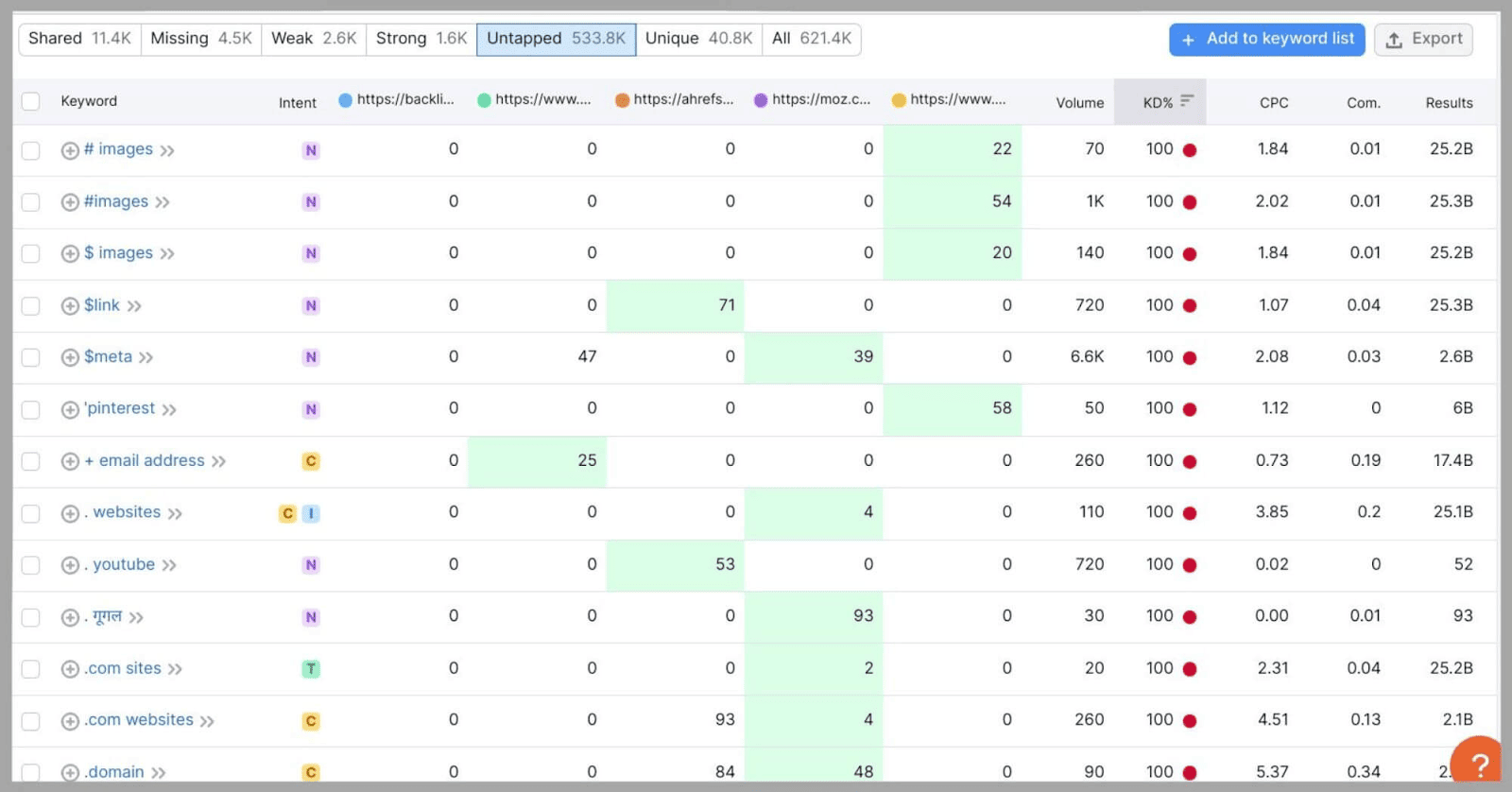
Based on the above example, it’s clear that this keyword analysis tool doesn’t always provide you with what I would describe as useful keyword suggestions.
However, if you type something more specific into the “Filter by keyword” search bar:
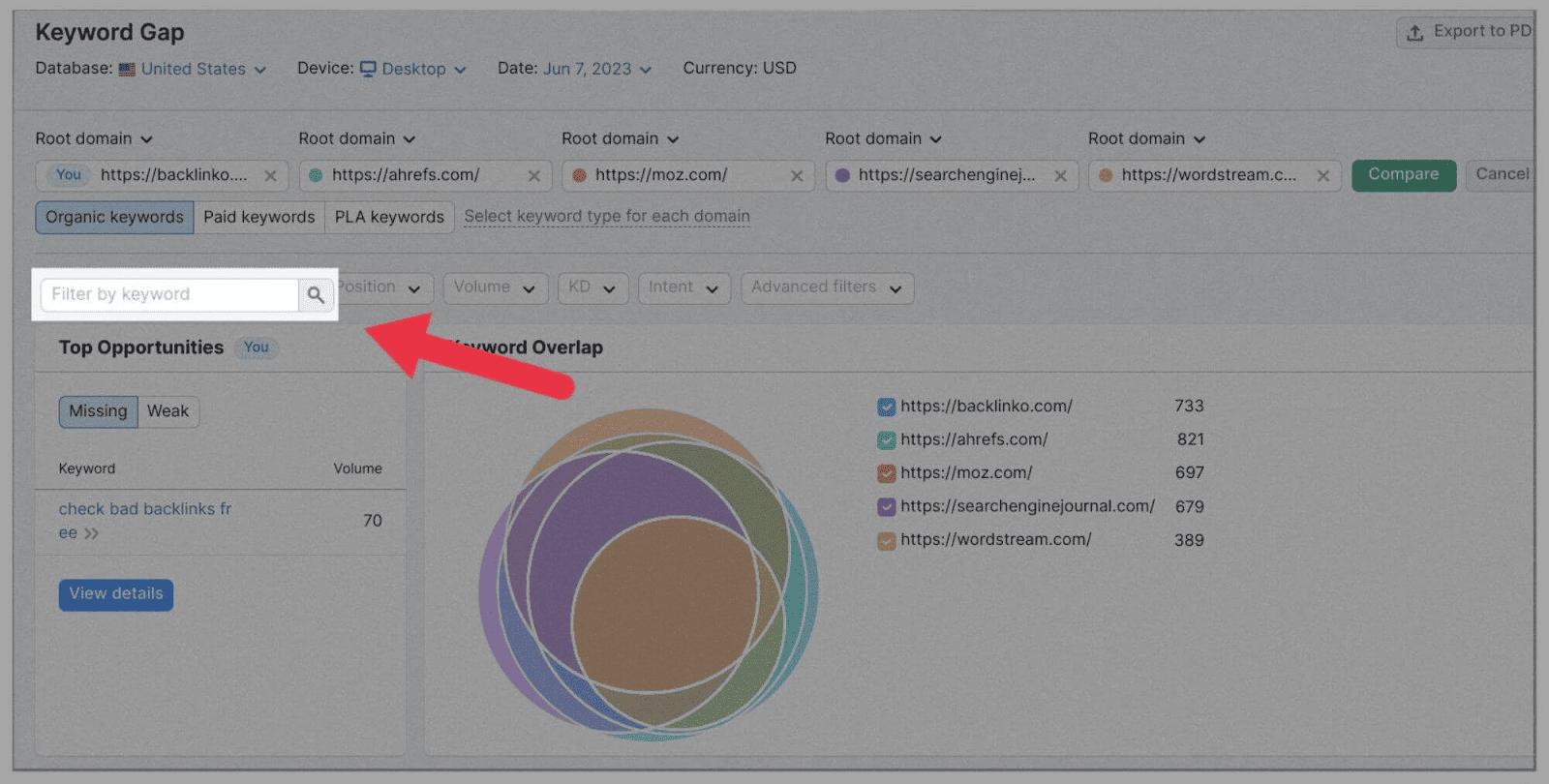
You can refine the results somewhat and uncover more practical keyword suggestions. I decided to search for “backlinks” in the filter search. After a bit of scrolling, I came across this keyword:

“Index backlinks” has a high search volume and a reasonable KD level of 33%. However, only Ahrefs and Moz are currently using this keyword in their content.
Given the low KD level, you could potentially rank for this keyword if you wrote a sound piece of content featuring it.
Analyzing Keyword Ranking
Keyword research and keyword analysis are ongoing battles. You’ve probably read this a lot in SEO blog posts (mine included), but it’s true for most aspects of this job. You’ve got to keep analyzing keywords even after you’ve published the content.
All the hard work you put into finding and analyzing keywords would be wasted if you didn’t check in on them and make changes where necessary.
Luckily, with the right tools by your side, checking the performance levels of your selected keywords isn’t too taxing.
For example, Google Analytics can be used to easily determine the keywords that are pulling in the most traffic.
Once you’re set up on Google Analytics, you can check your keywords by going to “Acquisition” > “All Traffic”:
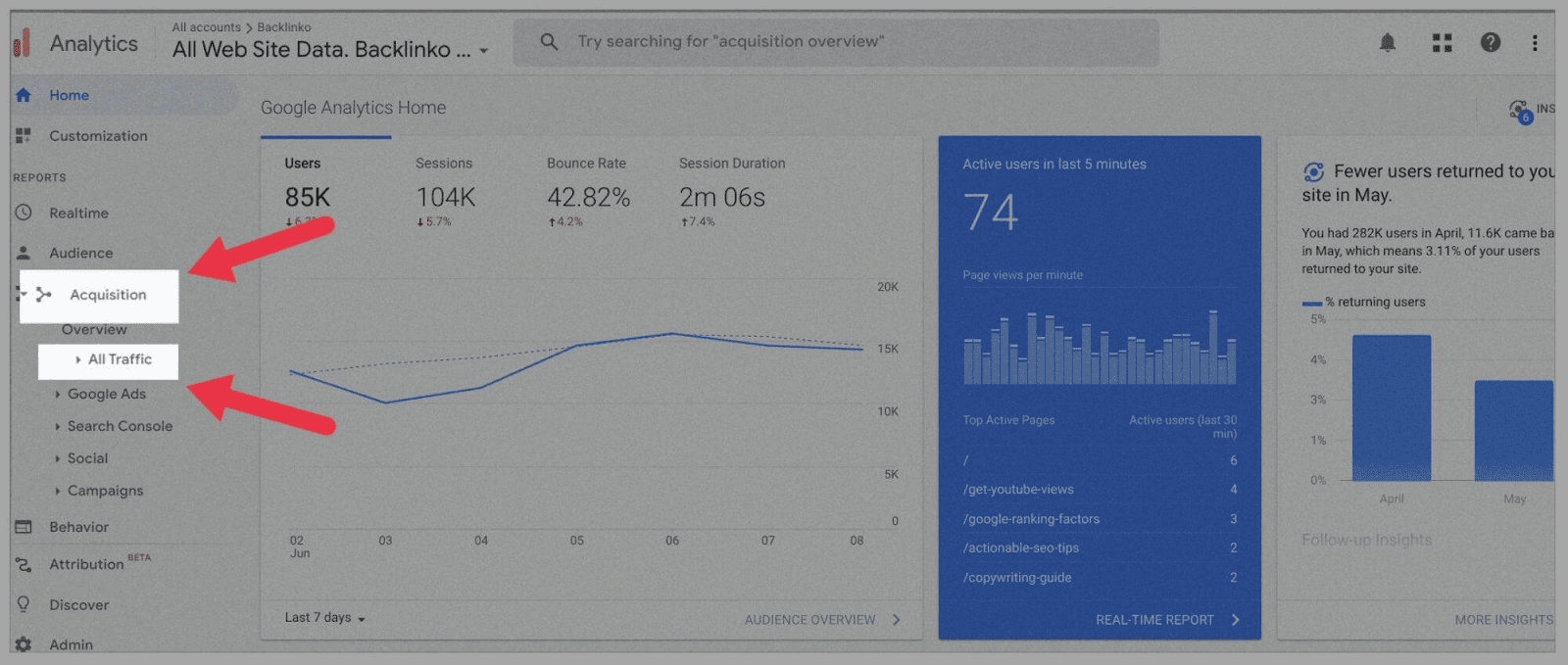
And then “Channels” > “Organic Search”:

You’ll then be presented with a table showing you the search data for specific keywords. It’ll look like this:

Could this be any easier?
You can also check to ensure that your keywords are allowing you to rank for the intended search queries, which you can see by following:
“Acquisition” -> “Search Console” -> “Queries”, as shown here:

You can then track which pages most visitors are landing on, as well as your conversion goal progress.
FAQs
What Must You Avoid When Conducting Keyword Analysis?
You should avoid only examining one metric while conducting keyword analysis—specifically monthly search volume. While it may seem the most promising metric, it doesn’t always guarantee you traffic and conversions.
The high search volume could be the result of a seasonal spike. Alternatively, the keyword might have already reached saturation, and be on the way down. For such reasons, it’s always worth looking at how the keyword has performed in the months leading up to the present. It’s also essential that you check other metrics, such as keyword difficulty.
How long should keyword analysis take?
Keyword analysis shouldn’t take you long if you’re using a premium keyword analysis tool. With a Semrush account, for example, you can gain information on keyword difficulty, monthly search volume, and conversion potential within seconds. Similarly, you can also find keywords during the preliminary keyword research stage in minimal time.
The vast majority of your time should be spent on planning and implementing a content strategy around the results of your keyword analysis.
Is keyword analysis still relevant?
Keywords are still relevant because they both define your content strategy and also help search engines and web users understand what your content is all about. Through keyword analysis, you can determine what topics you need to address in your blog. It also helps you better understand your target audience and the questions they are looking for you to answer.
On another level, keyword analysis helps you determine the keywords that will help search engines link up your content with your target audience. By strategically including and placing certain keywords, you increase the chances of search engines linking you with specific search phrases.
How often should I update and refine my keyword strategy?
You need to check in on your keyword analysis strategy at least once a month and update it whenever necessary. There’s no hard and fast rule as to how often you should update your keyword analysis strategy. However, every quarter you should check to see if there are any changes to search trends.
You should also regularly carry out competitive keyword analysis to identify new keyword gaps, for example. Even once you reach the top of the SERPs, you need to keep a comparative eye on your competition to maintain your position.

